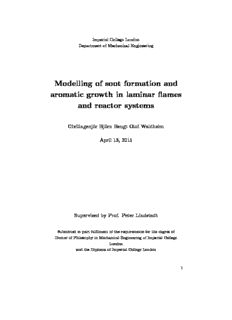
Modelling of soot formation and aromatic growth in laminar flames and reactor systems PDF
Preview Modelling of soot formation and aromatic growth in laminar flames and reactor systems
Imperial College London Department of Mechanical Engineering Modelling of soot formation and aromatic growth in laminar flames and reactor systems Civilingenjo¨r Bj¨orn Bengt Olof Waldheim April 13, 2015 Supervised by Prof. Peter Lindstedt Submitted in part fulfilment of the requirements for the degree of Doctor of Philosophy in Mechanical Engineering of Imperial College London and the Diploma of Imperial College London 1 2 The copyright of this thesis rests with the author and is made availableunderaCreativeCommonsAttributionNon-Commercial No Derivatives licence. Researchers are free to copy, distribute or transmit the thesis on the condition that they attribute it, that they do not use it for commercial purposes and that they do not alter, transform or build upon it. For any reuse or redistribution, researchers must make clear to others the licence terms of this work. 3 4 Declaration I certify that all material in this thesis which is not my work have been properly acknowledged. Bj¨orn Bengt Olof Waldheim 5 6 Abstract Soot particles formed and emitted from (e.g.) direct-injected diesel engines aredangeroustohumanhealthandlegislativemeasuresusedtoreduceemis- sionsposeatechnicalchallengeformanufacturers. Modelsofsootformation and oxidation may therefore be useful tools for developing engines and con- trolstrategies. Inthepresentwork,asectionalsootmodelabletoreproduce thesootparticlesizedistribution(PSD)isappliedtolaminarpremixedand di↵usion flames as well as a reactor system. The soot PSDs in laminar premixed stagnation flow flames were found to be sensitive to the coagula- tion collision e�ciency and a novel model was developed. The soot model under-predictedsootvolumefractionlevelswhenappliedtoasetoflaminar ethylene and propane counter-flow di↵usion flames and a sensitivity anal- ysis suggested further assessment of the formation of poly-cyclic aromatic hydrocarbons (PAH) was needed. The chemical reaction mechanism was subsequently assessed using species measurements from a laminar premixed benzene flame and selected parts of the reaction mechanism reviewed. Rea- sonableagreementwasobtained,includingforformationofPAHs. However, non-existing or insu�cient oxidation paths of some PAH species, including pyrene, may contribute to over-predictions by the soot model during non- sooting conditions. Formation of PAHs in a laminar ethylene counter-flow di↵usion flame was investigated next. The agreement between calculations and measurements was found to be reasonable for major, minor and single ring aromatic species. However, the calculated concentrations of all PAH species are under-predicted. The under-prediction of pyrene is comparable to the under-prediction of the soot volume fraction in some of the di↵usion flames previously investigated, making the uncertainty of the PAH chem- istryapossibleexplanation. Futuresootmodellingresearchshouldtherefore focus on investigating the PAH chemistry for di↵erent types of flames and fuels. 7 8 Acknowledgment I am very grateful for and have enjoyed the guidance, support and su- pervision of Prof. Peter Lindstedt. The co-supervision by Dr. Rolf Egnell and Dr. Ola Stenl˚a˚as have also been a pleasure. I am a also very grate- ful to Scania CV AB and the Swedish Energy Agency for their financial support making this research possible. I would like to personally thank Madelaine Nordqvist,Dr. Jonas Holmborn,Per St˚alhammar,Per Langeand Dr. Raymond Reinmann at Scania CV AB for their support. The support regarding calculations of thermodynamic data received from Dr. Roger Robinson at Imperial College is gratefully acknowledged. The management of references for the reaction mechanism by Peter Kraus, Dr. Valentini Markaki and Dr. Mark Lee Potter have been of great help and have been used in the current work. The structures of species drawn by Dr. Valentini Markaki have also been used in the current work and is gratefully acknowledged. I am grateful for the support and supervision from Prof. Bengt Johansson, Prof. Xue-Song Bai, Prof. O¨vind Andersson and Dr. Joakim Pagel at Lund University during my visit there. I wish all luck to all present and former collueagues at Imperial College that I had the pleasure to get to know and become friends with. I would also like to thank all present and former colleagues at Scania CV AB for their interest in my research and interesting discussions regarding mechanical engineer- ing. I am grateful to colleagues and friends at Lund University for their help regarding all kinds of matters. My beloved parents Lars and Eva Waldheim have always encouraged my curiosity and learning and together with my sisters Ingrid and Johanna Waldheim and relatives have always stood by my side. I also like to thank my friends in or from Stockholm, especially to those I grew up with in S¨atra, for there appreciation and all the great times we have had so far. 9 10
Description: